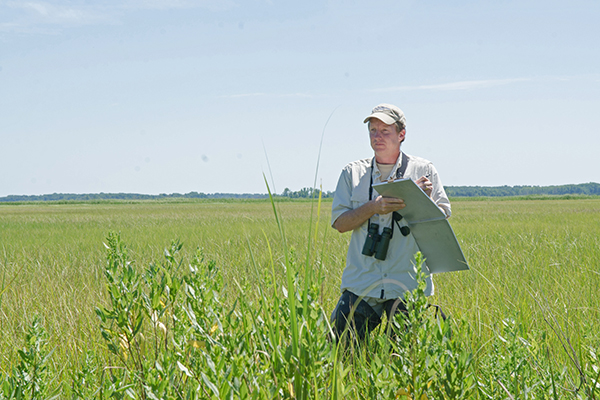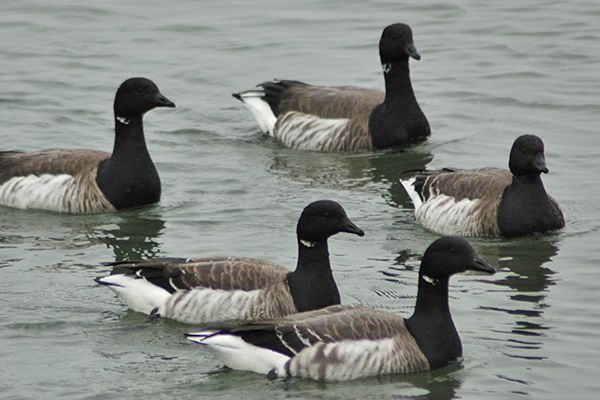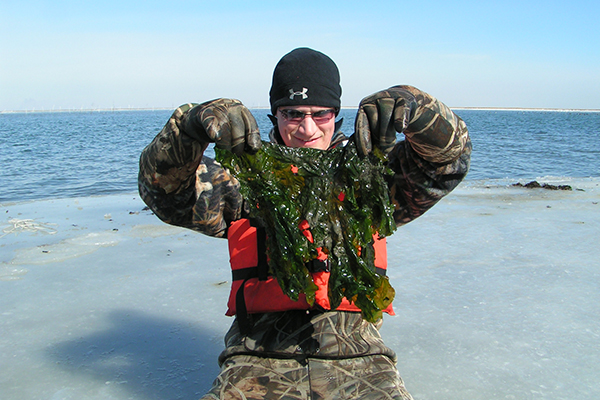Sandy restoration
Two UD professors assess habitat degradation in wake of Hurricane Sandy
11:32 a.m., Dec. 4, 2013--University of Delaware researchers Greg Shriver and Chris Williams have been awarded funds from a $162 million U.S. Department of the Interior project that will be invested in 45 restoration and research projects to better protect Atlantic Coast communities from future powerful storms by restoring marshes, wetlands and beaches, rebuilding shorelines, and researching the impacts and modeling mitigation of storm surge impacts.
Shriver and Williams will begin multiple projects to assess habitat degradation and restoration efforts with a focus on tidal marsh birds such as Nelson's and saltmarsh sparrows, the American black duck and the Atlantic brant.
Research Stories
Chronic wounds
Prof. Heck's legacy
Shriver, associate professor and assistant chair of the Department of Entomology and Wildlife Ecology (ENWC), and Williams, associate professor of entomology and wildlife ecology, were awarded funding in large part because of work that occurred before Hurricane Sandy and the amount of pre-storm data that they collected.
“We were both well positioned,” said Shriver. “The challenge with determining the effects of disturbances is having the pre-disturbance data; Chris and I both have that so we can go back to the same place after the disturbance and assess the effects.”
SHARP continued
Shriver’s work will build off of the pre-Sandy work that he is conducting as part of the Saltmarsh Habitat and Avian Research Project (SHARP) research. SHARP aims to provide the information necessary for all states in the bird conservation region stretching from coastal New England through the Mid-Atlantic to protect regionally important habitats for tidal marsh birds.
Of particular interest is the saltmarsh sparrow, which is listed as “vulnerable” by the International Union for Conservation of Nature and has a limited breeding range from Virginia to Maine.
“The SHARP surveys are conducted at over 1,700 locations from Virginia to Maine where we are sample breeding tidal marsh bird populations and vegetation communities so we have a nice extensive survey that goes all the way through the hurricane impact zone, from the most intense area all the way to Virginia and Maine,” said Shriver.
Another goal of the project is to provide a regionally consistent platform for tidal marsh bird monitoring in the face of anticipated sea-level rise and upland/watershed development to produce population estimates for all bird species found in the high tidal marsh -- including a global population estimate for saltmarsh sparrow -- and identify regional population centers.
Shriver said the research team has two years of pre-hurricane data from 2011-12, and explained that this project will last until 2016 with a big part aimed at assessing the effects of Hurricane Sandy restoration projects. “A lot of them will be happening on places we already surveyed, and we will survey new sites that are identified as tidal marshes that are going to be restored. We will complete pre- and post-restoration sampling so that, as we get into 2015-16, the focus will be on the ‘before and after’ restoration sites.”
Black duck, Atlantic brant
Williams’ research focuses on the American black duck, which has been a bird of priority concern in the Atlantic flyway and the Mid-Atlantic, as well as the Atlantic brant, which is a small goose.
Explaining that he has been working with Southern Illinois University and the state governments of Connecticut, New York, New Jersey, Delaware and Virginia, Williams said that his research has many facets. “We monitor the populations of these two species, how they’re using the habitat, how productive the habitat is in the way of feeding,” he said. “All of this work has been going toward the greater goal of assessing the potential on the landscape at a very large macro scale over a long period of time for the populations of black duck and Atlantic brant.”
Williams said his research is looking at the initial impact of habitat loss and the secondary effects, such as loss of food supplies and the impact that might have on population. “For the black duck, we can come in a year later and we can measure how much habitat there is, and whether the food has responded or not, and we can do that at all of these sites that we previously measured,” said Williams.
The research is a little bit more complicated for the brant. Williams explained that the brant mainly eat sea lettuce, algae and eelgrass, and it is likely those food supplies were severely impacted by the hurricane.
“Part of what we’re trying to do is better map and predict where those foods are on the landscape,” said Williams. “If the models we have created work well using remote sensing and geographic information systems (GIS), we can apply them to a series of aerial photographs that were taken pre- and post-Sandy. The goal is a really nice pre- and post-storm scenario to evaluate the effect that a destructive storm can have on the brant food supply.”
Williams said the researchers are both just happy that they can be of service to those communities impacted by the hurricane in any way possible. “From an academic standpoint, we’re lucky that we can help,” said Williams. “While we can only minimally help with the human component, we have a well developed program at UD to provide assessment of the ecological and wildlife community and provide recommendations for future landscape planning.”
Article by Adam Thomas
Photos by Danielle Quigley and courtesy of Chris Williams













